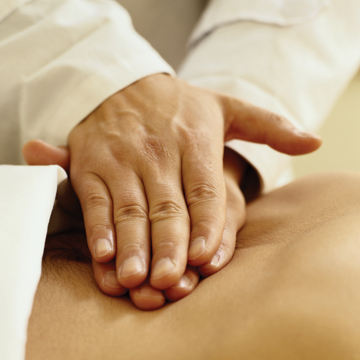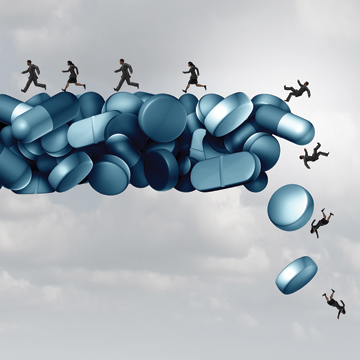Bringing medicine back to the bedside
The physical exam itself is widely considered to be underutilized, but many of the country's medical educators and master clinicians are determined to bring it back to prominence.
Physicians are literally leaving something on the table with their physical exams—and patients are noticing.
“My doctor doesn't touch me anymore” is a common complaint these days, especially among patients old enough to remember medicine before the emergence of ever-powerful technologies, said Ruth Berggren, MD, MACP, distinguished professor of medicine and director of the Center for Medical Humanities & Ethics at the University of Texas Health Science Center in San Antonio.

“There's a loss there. The patients are feeling it,” she said. “It undermines the therapeutic alliance that patients and doctors could have if proper attention and time were given to that aspect of the clinical encounter.”
But it's not as if physicians haven't also felt that something's missing. Incredible time pressures mean less time to see patients, let alone lay hands on them. In outpatient settings, physicians spend 27% of their time with patients and nearly twice as much time on electronic health records (EHR) and desk work, a 2016 study in Annals of Internal Medicine found. And interns may be getting cheated of even more patient time, spending just 12% at the bedside and 40% in front of computer screens, according to a 2013 study in the Journal of General Internal Medicine.
Given the sobering state of bedside medicine today, the physical exam itself is widely considered to be underutilized. But many of the country's medical educators and master clinicians are determined to bring it back to prominence.
Medical education solutions
One reason the physical exam remains important is that it helps guide the judicious use of technology, said Philip A. Masters, MD, FACP, ACP's Vice President of Membership and International Programs. “It's free except for the time that it takes to do it; it's of minimal harm to patients unless you're not doing the exam correctly; and it yields legitimate and good information that can help you more effectively apply the technology,” he said.
However, physicians' reliance on the physical exam has waned as other diagnostic tools have matured, said Davoren Chick, MD, FACP, ACP's Senior Vice President of Medical Education. “That's only natural,” she said. “But I think most of us feel that unfortunately, that also means that those special moments where the physical exam still has significant importance are in danger of being missed.”
Certain high-yield diagnostic physical exam maneuvers are even superior to the best available technology, said Steven McGee, MD, FACP, professor of medicine at the University of Washington School of Medicine in Seattle and author of the textbook “Evidence-based Physical Diagnosis.” “I think that's so important—probably the most important reason why students still need to be able to master the bedside exam,” he said.
There are many examples of conditions that are defined only by empiric observation, Dr. McGee said, quickly listing the entire fields of dermatology, neurology, rheumatology, and musculoskeletal medicine. Problems like cellulitis, Parkinson's disease, tenosynovitis, and trochanteric bursitis are all defined by bedside findings, he said. “For learners now, who are growing up in an era where, say, valvular heart disease is defined by echocardiography, their exam skills are just atrophying,” Dr. McGee said.
While physical exam skills may be declining, trainees remain enthusiastic about learning them, said ACP President Jack Ende, MD, MACP, professor of medicine and assistant dean for advanced medical practice at the University of Pennsylvania Perelman School of Medicine in Philadelphia. “The residents and students really do want to learn this,” he said. “But they don't because the frequency with which this is taught and the attention it receives, much to the frustration of the students, seems to be very little.”
In effect, trainees may see their skills peak in medical school, when the physical exam is emphasized the most, said Salvatore Mangione, MD, associate professor at Jefferson's Sidney Kimmel Medical College in Philadelphia and director of its physical diagnosis course. “Then they go out on the wards and they see that it's not really done, it's not really emphasized, and gradually they lose it,” he said.
In one study at four teaching hospitals, attendings taught physical exam skills just 14.6% of the time during general medicine rounds, according to results published in 2013 by JAMA Internal Medicine. “I think there's a prevailing sense amongst many of us who teach medical students that we better do something because this skill will vanish altogether,” said Abraham Verghese, MD, MACP, professor of medicine and vice chair for the theory and practice of medicine at Stanford University School of Medicine in California.
When visiting other institutions, he said he'll often ask trainees to perform an ankle tendon reflex test on a bedridden patient. “The most obvious thing that comes about is nobody has a hammer,” and even when they use one, they often fail to get a reflex, which can lead to an incorrect neuropathy diagnosis, Dr. Verghese said. “Our neurologists will tell us that people get sent to them for this expensive, painful test called the EMG, which is only because people don't quite know how to do these simple exams,” he said. “I think all we can do is enhance skills in individual programs.”
One residency program that is ramping up its focus on the physical exam is at Johns Hopkins University School of Medicine in Baltimore. In 2015, ACP Member Brian Garibaldi, MD, assistant professor of pulmonary and critical care medicine, designed the Advancing Bedside Cardiopulmonary Examination Skills (ACE) curriculum for interns rotating on a general medicine service. The four-week program gives clinicians protected time each morning to go to patients' bedsides with a focus on demonstrating and practicing cardiopulmonary elements of the physical exam.
The effort has led to measurable improvements. Over the last two years, compared to interns who have not yet gone through the curriculum, those who've completed it have improved confidence in their exam skills, believe they've received more adequate training in the physical exam, and have demonstrated significant improvement on a validated test of cardiovascular exam skill, according to results published in October 2017 by BMC Medical Education.
More recently, Dr. Garibaldi started using actual patients to test trainees' physical exam skills as part of a Practical Assessment of Clinical Exam Skills (PACES), modified with permission from the original framework used by the Membership of the Royal Colleges of Physicians of the United Kingdom. A point-of-care ultrasound station is the newest addition to the PACES’ cardiopulmonary and neurological stations, he said. Beyond its diagnostic importance, point-of-care technology brings physicians back to the bedside, allowing them to spend time in shared discovery with patients, Dr. Garibaldi said.
“I feel like there's a perceived conflict between the physical exam and technology,” he said. “I don't think they're in conflict; I think they're complementary. … I think that's the wave of the future.” Dr. Garibaldi said he anticipates that the “clinical exam 2.0” will also incorporate other point-of-care technologies, such as digital stethoscopes that provide discriminative value based on waveform analysis of sound.
Broader efforts in practice
Now more than ever, internists are squeezed for time. Still, some are finding ways to maximize their bedside presence—and for good reason. In addition to saving health care costs, the physical exam can boost patients' confidence in physicians, physicians' satisfaction with the practice of medicine, and clinical competency in resource-limited settings, Dr. Berggren said. (An illustration of that last point: During Hurricane Katrina at Charity Hospital in New Orleans, her neurological exam skills allowed her to safely perform a therapeutic lumbar puncture on a patient with cryptococcal meningitis without doing a CT scan.)
However, no one has time for a complete head-to-toe physical exam, Dr. Berggren said. “Don't go through the entire ritual for ritual's sake,” she said. “When we have limited time, we should use techniques that are proven to make a difference in terms of decreasing the need for extensive diagnostic testing.”
While it's not necessary to do a complete exam, a brief yet thoughtful physical exam helps physicians create a bond with patients, said Jerome P. Kassirer, MD, MACP, distinguished professor at Tufts University School of Medicine in Boston. “A cursory exam kind of tells the patient, ‘Well, I'm not all that interested,’ so doing more than a cursory exam is important,” he said.
Dr. Masters said he touches virtually all patients at some point during the clinical encounter, even if they don't come in for a particularly active medical problem. “I personally think there's value to that,” he said. “In many respects, fostering the doctor-patient relationship is as valuable as many diagnostic tests that you can do.”
The human touch of the exam can even change the communication between patients and doctors, said Danielle Ofri, MD, PhD, FACP, an internist practicing at Bellevue Hospital in New York City and an associate professor of medicine at New York University School of Medicine. “With a computer between you, it's very sterile. It's hard to talk into the air when your doctor's typing away,” she said. “When you go to the exam table, however, that's the moment when you're actually with the patient without any technology. I find that the exam becomes the refuge for good history-taking.”
There are also ways to reinvigorate physical exam skills in private practice. For example, even if a patient comes in with a heart murmur and next steps will be determined by an echocardiogram, Dr. McGee recommends jotting down in your own notes what the cause of the murmur may be and then comparing that hunch to the echo results. A right answer builds self-confidence, whereas a wrong answer does no harm to the patient but gives physicians the opportunity to review what went wrong, he said. “Then their confidence will build up with their bedside skills, and they'll realize that their bedside observations are meaningful,” said Dr. McGee.
On a national level, efforts such as the Stanford Medicine 25, which promotes bedside exam skills (it started with 25 techniques but has added more), have led a new generation of physicians to champion the physical exam, said Dr. Verghese, who in 2011 established the Stanford initiative in an effort to teach both trainees and educators. Several early- and mid-career physicians launched the Society of Bedside Medicine in 2017 to coincide with the annual Stanford 25 Bedside Medicine Symposium.
So far, the group is made up of more than 100 members from 75 institutions who are dedicated to reinvigorating physical exam skills and incorporating emerging bedside technology into the traditional exam, said Dr. Garibaldi, the group's co-president. “There are many people across the country who are … working together to figure out how we can reinvigorate those skills in the current environment,” he said.
But for Dr. Mangione, the current environment is the true problem, and the decline of the physical exam is only a symptom. “The larger problem is the demise of this bedside-centered, humanistic healer, which is more and more being replaced by technicians,” he said. “Burnout could be something that finally gets people's attention, because ultimately burnout means that physicians quit.”
To that end, a return to bedside medicine will ultimately connect physicians to the meaning of their work, Dr. Berggren said. In practice, her solution is to avoid spending much time on the computer in the presence of patients, deferring charting activities until later “even if it bites into my sleep because I don't want to sacrifice that precious time that I have with the patient.” Although some might say the practice could lead to exhaustion and burnout, Dr. Berggren would argue the opposite. “Counterintuitively, that behavior of mine … is an antidote to my burnout,” she said.



